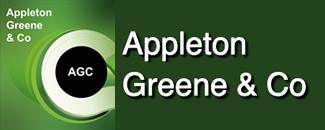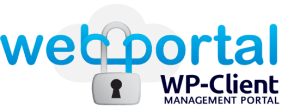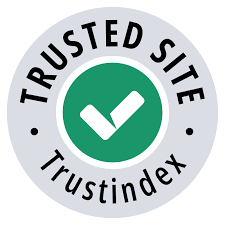Behavioral Science
The Appleton Greene Corporate Training Program (CTP) for Behavioral Science is provided by Dr. Heft PhD Certified Learning Provider (CLP). Program Specifications: Monthly cost USD$2,500.00; Monthly Workshops 6 hours; Monthly Support 4 hours; Program Duration 12 months; Program orders subject to ongoing availability.

Personal Profile
Dr. Heft is Behavioral Scientist and Psychologist dedicated to helping people and organizations become more successful. Understanding that we, as humans, are surprisingly unaware of why we do what we do and what influences our decisions, she is committed to leveraging the power of behavioral science to improve lives. Dr. Heft delivers science-based solutions that drive higher performance through consulting, training, and coaching. She has over 25 years of experience in Fortune 500 companies as an internal consultant. Her educational background includes a Bachelor of Science degree in Business Administration, a Master’s in Psychology, and a Ph.D. in Industrial/Organizational Psychology. Dr. Heft started a Behavioral Science function at a large financial services firm, where she applied the insights of Behavioral Science to the table to solve a wide range of challenges. One of the larger scale projects included conducting a multi-year research project to align behavioral science research related to motivation, reward, and recognition systems to drive performance. In addition, recognizing individual differences in motivation, they segmented the sales group to tailor solutions and drive performance. Today, she continues to consult with them on major projects and conducts research to leverage behavioral science principles to get better results. Since she worked as an internal consultant, Dr. Heft has a deep understanding of the opportunities and challenges facing you. This background helped her build a Behavioral Science program that is extremely practical and focused on helping you navigate your organization to deliver better results every day.
To request further information about Dr. Heft through Appleton Greene, please Click Here.
(CLP) Programs
Appleton Greene corporate training programs are all process-driven. They are used as vehicles to implement tangible business processes within clients’ organizations, together with training, support and facilitation during the use of these processes. Corporate training programs are therefore implemented over a sustainable period of time, that is to say, between 1 year (incorporating 12 monthly workshops), and 4 years (incorporating 48 monthly workshops). Your program information guide will specify how long each program takes to complete. Each monthly workshop takes 6 hours to implement and can be undertaken either on the client’s premises, an Appleton Greene serviced office, or online via the internet. This enables clients to implement each part of their business process, before moving onto the next stage of the program and enables employees to plan their study time around their current work commitments. The result is far greater program benefit, over a more sustainable period of time and a significantly improved return on investment.
Appleton Greene uses standard and bespoke corporate training programs as vessels to transfer business process improvement knowledge into the heart of our clients’ organizations. Each individual program focuses upon the implementation of a specific business process, which enables clients to easily quantify their return on investment. There are hundreds of established Appleton Greene corporate training products now available to clients within customer services, e-business, finance, globalization, human resources, information technology, legal, management, marketing and production. It does not matter whether a client’s employees are located within one office, or an unlimited number of international offices, we can still bring them together to learn and implement specific business processes collectively. Our approach to global localization enables us to provide clients with a truly international service with that all important personal touch. Appleton Greene corporate training programs can be provided virtually or locally and they are all unique in that they individually focus upon a specific business function. All (CLP) programs are implemented over a sustainable period of time, usually between 1-4 years, incorporating 12-48 monthly workshops and professional support is consistently provided during this time by qualified learning providers and where appropriate, by Accredited Consultants.
Executive summary
Behavioral Science
What exactly is Behavioral Science, and do we need it in our business?
The field of Behavioral Science is a fascinating, influential, and fast-emerging specialty area. It has the potential to make a very large impact on organizations, sometimes in surprising ways, and with relatively minimal resources. It is the study of human behavior, which includes how your customers and employees make decisions, what they do and buy in real-life situations. In truth, the field started when researchers discovered that people often don’t do what they should do or act in the most rational way.
Behavioral Science was born from a desire to understand why and how this happens and what we can do to overcome those limitations. Today in business, we use this science to build a better mousetrap. For example, how can the design of an invoice influence the accounts receivable payment rates (attention and cognitive load)? Why are employees more willing to try a new process when they learn that their peers are using it (social proof)? Have you ever wondered why people are willing to pay so much for Apple products? That’s right, Apple used behavioral science to design their products and marketing to create repeat customers. These are just a few examples of the many principles of behavioral science and how they can have a big impact on your business.

And so yes, you need Behavioral Science in your business! In fact, understanding human behavior is your business. In most cases, your success depends on how well you interact, influence, and engage with your company’s stakeholders (i.e., customers, employees, suppliers, shareholders, regulators, and your community). In addition, don’t most business activities involve some kind of behavior change? Whether you are designing products, selling new services, increasing productivity, motivating employees, or setting strategy, Behavioral Science can help improve results across the board. There are actually very few areas in business that couldn’t benefit from what Behavioral Science has to offer.
So why is Behavioral Science so important, and how is it having such a big impact? That’s simple: the field combines research on brain science, economics, psychology, and emotions and runs experiments to find out what works in the real world (not just in a lab or university setting)!
We’ve learned that even very small psychological pushes, or “nudges,” can have a huge impact on employee performance. For example, did you know that customers offered two products are more likely to pick a more expensive one, but only when a third, even more expensive product is also offered (choice architecture)? Similarly, would your web-design team be surprised to find out that repositioning the words and images on your website can increase sales? It becomes more and more obvious that Behavioral Science is a powerful tool that’s been missing from your toolbox.
Don’t get left behind! While Behavioral Science has been around for a while, it’s been used most in the public sector by government and non-profit groups. However, it is making fast inroads in the private sector. Large and small companies like Amazon, Google, Netflix, Wal-Mart, Coca-Cola, IBM, Pepsi, Nestle, Facebook, Snapchat, Bumble, Morningstar, NASDAQ, Headspace, Calm, and Lemonade are just a few of the companies leveraging behavioral insights to succeed. In a 2020 survey, 597 companies reported building Behavioral Science programs, and the majority of them had only started in the past 6 years1. There’s no doubt this field is taking off. If you decide to leverage Behavioral Science, you’ll be in good company and may get a jump on your competition.
In fact, understanding human behavior is becoming increasingly important for remaining relevant with your customers. Their appetite for products and services that are smart, designed well, easy to use, and make their lives better is growing. Like you, they are “wowed” by the new features they are exposed to every day on their favorite apps, websites, the services from the hospitals and entertainment venues they visit, and in the products they use. Because your customers are delighted by these changes, they are likely to have even stronger reactions when they experience frustrations with packaging, products that aren’t intuitive, confusing technical terminology, and websites that are difficult to navigate. Can you remain relevant when your competitors are leveraging Behavioral Science and you aren’t?
So, the million-dollar question is: How can you help your company leverage Behavioral Science to drive better results?
Enter the Behavioral Science Program. This program allows you to teach your employees to use Behavioral Science principles in their everyday work as product designers, marketers, and communication and human capital experts. Frankly, the list of areas your firm could benefit from with Behavioral Science is just too long.
What challenges are you facing? Do you need: a new breakthrough with product design, a better way to reach prospective clients and turn them into customers, a way to get your employees on board with a policy change they don’t like, a way to figure out what went wrong with the rollout of a new product and then a way to fix it, or maybe some other big, difficult problem you have been unable to solve and need help with? No worries. The Behavioral Science program will help you identify small changes that yield big results. The Behavioral Science program will help you break it down, diagnose gaps between current and future states, identify the most critical behaviors, and put plans in place with the best ROI to get the results you need.

The best part of introducing this program to your firm is that you don’t have to hire a group of behavioral scientists or engage a boutique consulting firm each time you need their help with an important project. While Behavioral Science is based on big, complex, academic concepts, leveraging the core principles doesn’t have to be overly complicated. The year-long Behavioral Science program will train you and/or your associates to apply Behavioral Science in monthly, bite-sized learning sessions. They’ll learn to use these principles through a repeatable, systematic process that will allow them to get better results. Throughout the process, they’ll be applying their new knowledge and skills to a real problem(s) they are working on solving in your firm. The program is based on experiential learning, which means an essential part of their development will be putting the Behavioral Science tools and processes to work. The best part is that they don’t need to become psychologists or scientists to benefit from using the tools. You can become a hero in your organization by going through the program yourself or by introducing the program to train a group of employees to use these important principles in their daily work.

There’s no mistake about it: unleashing the power of Behavioral Science in your organization will be a definite competitive advantage. Behavioral Science principles can improve results across the board.
Just remember, the one thing your customers, employees, leaders, shareholders, and community stakeholders all have in common is being human – they are all subject to the benefits and limitations of being human. Understanding how to tap into the science behind how we operate is the key to growing your business. Don’t hesitate; find out where you could be getting better results. Harnessing behavioral science allows you to design better products, build websites that improve sales and user loyalty, deliver marketing campaigns that grab your customers’ attention, increase efficiency and productivity in your manufacturing facilities, and enhance the adoption of new employee initiatives.
1 Who Is Doing Applied Behavioral Science? Results from a Global Survey of Behavioral Teams
Stephen Wendel Behavioral Scientist, October 5, 2020
Curriculum
Behavioral Science – Part 1- Year 1
- Part 1 Month 1 Successful Planning
- Part 1 Month 2 Define the Goal
- Part 1 Month 3 Define Outcomes
- Part 1 Month 4 Create a behavior map
- Part 1 Month 5 Identify & prioritize key behaviors
- Part 1 Month 6 Identify barriers to behavior
- Part 1 Month 7 Identify and prioritize strategies to overcome barriers
- Part 1 Month 8 Understanding key tactics of behavioral science
- Part 1 Month 9 Identify Tactics to overcome barriers
- Part 1 Month 10 Develop an Implementation Plan
- Part 1 Month 11 Experimental Design
- Part 1 Month 12 Measure Success
Program Objectives
The following list represents the Key Program Objectives (KPO) for the Appleton Greene Behavioral Science corporate training program.
Behavioral Science – Part 1- Year 1
- Part 1 Month 1 Successful Planning The first module, Successful Planning, guides participants in taking the necessary steps to establish a successful project. Planning is often an overlooked but extremely critical part of a BS project. During the workshop, participants will gain an understanding of their role as the process leader, the roles of other stakeholders, and best practices for engaging with their stakeholders. In order to effectively prepare, they’ll be introduced to several key planning tools, and how they are applied specifically for a Behavioral Science project. More importantly, they’ll be provided with a foundation for the basic components of data collection, analysis, and reporting. Getting a head start on data collection is a vital ingredient for facilitating a successful project.
- Part 1 Month 2 Define the Goal One of the most important steps is to create a vision of the future state of the challenge. While this may seem obvious, it is more challenging than it appears. The size and scope of various challenges may differ greatly. More complex, larger scale challenges will likely have multiple goals or subgoals. For example, a challenge could be to increase usage of a tool or sales of a product. However, there are trade-offs in terms of how this can be done. For example, there are likely multiple dimensions of success to consider. Sales are one aspect, longer term client loyalty, client experience, referrals of the product, or sales team advocacy could all be critical aspects of reaching the goal. However, the approach for achieving these different aspects can vary greatly. A large part of the work of this step is to define multiple important aspects of the goal, and also to prioritize the most critical aspects. It is also important to identify & involve appropriate stakeholders and understand research on what factors lead to goal setting success.
- Part 1 Month 3 Define Outcomes Following identification of a goal the next steps is to get more specific with outcomes. The outcomes are less abstract and conceptual than goals and should be more tangible and measurable. Many projects fail to identify critical outcomes and appropriate metrics for determining outcomes, but this is a mistake because identifying outcomes helps to clarify goals ensure the projects stay on track with measurable outcomes. This section will support the determination of different methods of testing for success, including milestone progress checks as well as end result metrics. This section will cover both “hard” tangible measures as well as “softer” ways to measure success such as attitudinal and intentional measures. This module will also include best practices for measurement and building systems to track progress. Finally important partnerships with stakeholders who have access and capabilities to analyze data will be addressed.
- Part 1 Month 4 Create a behavior map Often organizations look for a specific “behavior” from a consumer or employee, but do not recognize the series of intermediate steps that can be influenced along the way. A behavior map (similar to a journey map) provides a realistic picture of the series of potential sub-steps and different paths that can lead to a specific outcome. Leveraging a behavior map can help with the identification of the most crucial behaviors needed to move toward a specific behavior. The interplay between attitudes and mindsets with behaviors will be examined here.
- Part 1 Month 5 Identify & prioritize key behaviors Following the creation of a behavior map, the next step is to identify and prioritize key behaviors to target for intervention. There is some art and science involved here, but choices must be made for more complex behavioral changes and identifying the necessary and optional behaviors, as well the sequence can be critical. Some behaviors may seem insignificant but can be obstacles to achieving the project goals so they must be addressed. This step can also be important for breaking the project into appropriate phases as needed to ensure foundational steps are not missed in the plan.
- Part 1 Month 6 Identify barriers to behavior Now the real fun begins! In this step we’ll take a systematic approach to identifying the core Behavioral Science barriers to success of the behavior. Several models of organizing barriers to behavior change have been developed. These models allow practitioners to comprehensively explore all of potential barriers to a behavior in order to diagnose and intervene on the most powerful barriers blocking progress. For example, on many projects, stakeholders put plans in place to develop and present a powerful business case for the change. In reality, while this may be important, many may already buy into the business case, but other bigger obstacles may be blocking adoption (e.g. no capacity, lack of confidence, system issues, etc.). Unless these obstacles are identified and addressed, little progress is possible. This step also helps inform other stakeholders who are attached to a particular solution.
- Part 1 Month 7 Identify and prioritize strategies to overcome barriers This module will support the identification of strategies for the action plan. There are over 120 biases that influence behavior. A model is presented that include 14 different strategies for overcoming typical barriers to behavior. The principles will be organized and categorized in way that helps students rely on the principles, without remembering all the details to select the best strategies for their challenges. Each of these strategies will be reviewed for research and examples of how and why they are relevant. Often there are many different ways to tackle challenges. Guidelines will be discussed for how to prioritize and combine various strategies for success.
- Part 1 Month 8 Understanding key tactics of behavioral science Some of the most relevant of the 120 biases and the core behavioral science principles will be reviewed. This will include some interactive examples of the research and prior research studies to illustrate how we are all influenced by these principles (whether we want to be or not). Specific tactics related to each of the strategies will be reviewed and discussed as potential interventions for the challenge identified. These tactics are all examples of the strategies, but at a more practical level (the strategies are higher level groupings of the tactics). Discussions about the practical and effectiveness trade-offs of various tactics will be undertaken to help prioritize the most impactful tactics.
- Part 1 Month 9 Identify Tactics to overcome barriers The next step in the process is to identify a specific tactic(s) within a strategy to overcome barriers to performance. A model is presented that includes multiple relevant potential tactics for overcoming typical barriers. Each of these tactics will be reviewed for research and examples of how and why they are relevant. This framework will then be applied to an example case, and then to each participant’s challenge. This step is one of the most important parts of the process of to removing barriers to the change. Getting down to the best specific tactics will become the building blocks of the plan for moving forward. This framework will be available to leverage every time a new project or challenge is encountered.
- Part 1 Month 10 Develop an Implementation Plan This module will include information on putting together the specifics of the project plan, including phases, milestones, stakeholders, sub-goals, etc. in order to deliver on the plan. Implementation of the tactics may involve collaboration with other groups to plan and coordinate the details of the tactics. For example, updating the landing page on a website could include working with your Communications team, Marketing, technology, etc. Depending on the size and scope of the tactic, a coordinated project plan may be in order. Larger projects may even require a phased project plan. Additional coordination is likely necessary when your intervention includes rolling out multiple tactics. Sometimes an iterative process (tacking foundational behaviors first, and more advanced behaviors at later stages) could be a better alternative for complex initiatives.
- Part 1 Month 11 Experimental Design Behavioral science is steeped in the idea of experimenting with your approach within your organization and the specific context of your challenge. So even though you established a measurement plan for outcomes at the beginning of the process, at this phase it’s important to design a specific experiment around your solution. This is important because the tactics are based on general research. Even though an intervention worked for a certain organization (or another part of your organization) in the past, the situation within your organization may be different and will yield different results. That is why running a pilot test your intervention before introducing it on a broad spectrum is recommended. Experimentation should definitely be part of your plan; this is how you measure the success of your efforts. This allows you to fail fast to learn. It also helps you conclude what really works and what doesn’t. Over time, you’ll gain a deeper understand of the intentions that work for your customers, products, employees, and organization. This module introduces you to the key considerations of experimental design.
- Part 1 Month 12 Measure Success This module is focused on measuring the success of your project and using data to make your decision to continue, tweak or sunset your project. In this module, you’ll learn about how to present the results of your project in the best way possible to aid in understanding the data. You’ll also learn to tie the results back to the original objectives of the project, and the best ways to engage your stakeholders in the decision making about next steps. You’ll also learn about best practices for celebrating team success and for doing a debrief or post-mortem to better understand what worked best and what could be done differently. You’ll also have an opportunity to examine the process and make tweaks for future project administrations.
Methodology

Behavioral Science
The field of Behavioral Science brings together insights from psychology, economics, neuroscience, finance, and the social sciences. It has a very broad scope, and so you may be overwhelmed by the thought of learning how to leverage Behavioral Science in a one-year program. Well, it is possible to gain a workable understanding of the key principles and apply the training through a systematic process. That’s right, you won’t become a psychologist or neuroscientist, but you will be able to leverage the core principles of Behavioral Science to solve problems in new and better ways at work. In fact, Behavioral Science principles were used to build this program to work best for you. The training is organized in the right way, in the right sequence, and with the right application and tools to make the program and the participants successful.
Process Overview
The process starts with a clear definition of your goals and progresses to an assessment of the current state and gaps from a Behavioral Science lens. The next steps involve identifying what behaviors specifically need to change, what barriers exist, and how to identify strategies and tactics to overcome the obstacles. Finally, the solutions can be pilot tested to determine their effectiveness before being implemented full-scale. Of course, as a scientific discipline, the training includes an emphasis on discovery, testing assumptions, experimentation, and measurement of results. While these steps may not be new to you, working from a Behavioral Science perspective will yield different results.
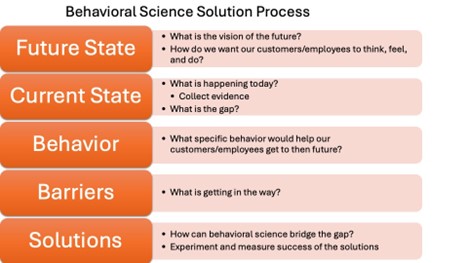
Models and Frameworks
Within each step of the process, you’ll be introduced to tools, models, and frameworks for addressing your challenges. Some examples are included here.
Evidence: Data Collection and Experimentation
One of the most important tools in the behavioral scientists’ toolbox is the ability to measure and collect evidence so organizations can make data-based decisions. These tools will be used at the front end of the process as we collect data on the current state regarding why people are behaving the way they are. We’ll leverage these tools again, and to a greater extent at the end of the process, to measure whether our interventions were successful and demonstrate a return on investment. The diagram below is helpful in demonstrating You’ll be introduced to several models of measurement in this program.

Behavioral identification and mapping
In order to identify the root cause of a challenge and drive target behavior, specific outcomes need to be dissected to uncover and troubleshoot various obstacles along the way. This is similar to examining a process flow in process improvement work. While this may seem rather simple, human behavior is rarely straightforward. For example, there are typically multiple ways to arrive at a specific outcome. Through the process, you’ll also learn to distinguish between required and option steps, important decision points, and pivotal choices to take different paths.
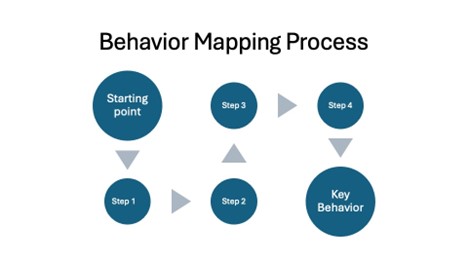
Understanding Behavior and Human Performance
The program will include the underpinnings of psychology to help understand human behavior. These principles will be broken down into easy-to-understand and apply models. For example, the simple but very complete model below can be used to diagnose almost any behavior or performance challenge. It is simple yet elegant in its ability to explain the multitude of factors that influence human behavior. Basically, if a person is motivated to do something, has the ability, has effective reminders or triggers, and is not blocked by something outside of them, they will engage in the behavior. This can also be useful in understanding which aspect is not working when someone is not engaging in the desired behavior.

Comprehensive Analysis of Barriers
The list of questions below will be leveraged in the program to help participants apply a comprehensive, structured approach to uncovering barriers and obstacles to performance. While this seems like a simple list of good common-sense questions, there is science behind each question, and it is a powerful device for identifying appropriate solutions for each of the obstacles.
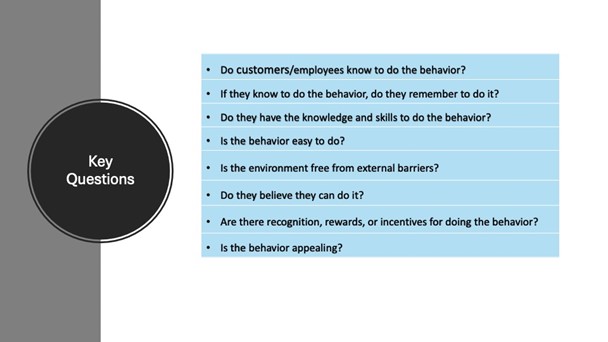
Bring a real problem to the table
To get the best results, you’ll want to bring a project or real problem to the table to work on in the program. If you have a year or more to work on the project or solve the problem, that would be ideal since you can work in parallel with the 12-month program. This may be a challenge if you have work that needs to be completed in less than a year. If this is the case, you could introduce a series of smaller challenges throughout the program. While it’s always ideal to start from the beginning, it’s almost never possible in real organizations. The process and tools introduced in the program will allow you to contribute in a new way, regardless of the stage of development. Alternatively, one idea is to work on a new idea or challenge that isn’t being actively pursued by the organization (e.g., maybe it’s too big to tackle, there are not enough resources now, or it’s not a priority). This allows you to work in a “safe zone” without too much pressure to accelerate in a way that’s not aligned with the learning. Eventually, you can integrate the project into your organization’s processes after you’ve made good progress on a solution.
Industries
This service is primarily available to the following industry sectors:

Financial Service Industry
The financial industry is extremely important in ensuring the economy functions efficiently. Consider this: essentially all businesses and consumers are users of financial products and services, so these companies play an integral role in the lives of consumers, businesses, and institutions.
This industry includes a large group of companies, such as banks, consumer finance companies, transaction and payment processors, securities and brokerage firms, and insurers.
Since the 2008 financial crisis, this industry has been in a constant state of flux. For companies in this industry, survival depends on the ability to stay vigilant and adaptive to changes in economic conditions, the regulatory environment, litigation, data security breaches, and changing business models.
Despite these risks, financial service companies can remain relevant and grow by taking advantage of technological advancements, building partnerships that strengthen and/or protect them, and delighting their customers. More specifically, these businesses can insulate themselves from some sources of volatility by appropriately and fairly handling complaints as well as anticipating and delivering on customers’ needs.
There are several trends that can help drive the sector in the long run, including: 1) a growing global population; 2) the globalization of economies; and 3) technological advances.
As developing economies grow and wealth accumulates, there will be an increasing need for more people and businesses to have access to a wide variety of financial products. As globalization continues to expand, there will be an increased need to easily transfer money across borders. As these people live longer, there will be a need for them to save and plan for retirement. Finally, as technology continues to improve, it will be more efficient for companies to offer financial products globally.
Some financial services organizations have already discovered Behavioral Science and are using it to help clients save more money, minimize employee misconduct, and encourage e-delivery over paper statements). There is a lot of room for this field to make a far wider impact.
Couldn’t your company leverage behavior science to improve the digital experience, encourage self-service options, on-time bill payments, and design communications that motivate desired behaviors?

Technology
Technology is big business. In fact, it is the largest component of the S&P 500 index. It plays an essential role in our personal lives and in most organizations across the global economy. For businesses (which could include government entities), technology needs range from buying new computers to building out data centers. The products and services in this space include, for example, hardware and equipment, software, and services (e.g., mobile application development), and semiconductors and semiconductor equipment.
The outlook for the technology industry is bright for several reasons. Many businesses continue to invest in newer technology to increase efficiency and enhance the overall customer experience. In addition, with the emergence of cloud services, big data, and artificial intelligence, more companies are moving their technology platforms to the cloud and investing in data analytics with the goal of cutting costs and creating a more seamless, tailored experience for customers. Consumers are also demonstrating a healthy appetite for connected devices (e.g., thermostats, smart lights, locks, phones, speakers, etc.). This has resulted in increased demand for the parts needed to make a device smart and the need for more network connectivity. Finally, the expansion of 5G services points to additional technology growth in order to build the components and infrastructure needed. These changes suggest there will be strong demand for technology products and services in the foreseeable future.
There are several challenges the technology industry is facing. The first is the focus on increased regulation of large technology companies to ensure fair competition. A second is on artificial intelligence to protect intellectual property and other misuses. Another area of concern is related to many technology companies’ reliance on global suppliers and/or the exportation of their products internationally. These companies could be impacted by new or changing tariffs, other trade regulations, or new trade deals. Supply chain issues can also plague companies that manufacture technology products, which was a great concern during the COVID pandemic. Finally, because technologies are changing so fast, it is difficult to stay current and know which research and development investments will pay off. If a technology company cannot keep up with the pace of change or is behind their competition, they could lose customers and maybe even become obsolete.
The importance of designing products and interfaces that are user-friendly and secure has never been greater. To stay ahead of the curve, experts in the field are turning to behavioral science. Tech companies spend a lot of time and money designing websites, apps, and user interfaces. They really can’t afford to lose customers when the sites are hard to navigate or when customers don’t use them in the way intended. For example, even small changes such as modifying the word on a call-to-action button can increase clicks, or talking about technology in terms of its benefits instead of technical terms has been shown to be more motivating to consumers. Behavioral science suggests that people learn best through interactive, hands-on experiences that mimic real-life situations, not traditional training manuals, programs, or even videos. Making the training more fun or competitive (i.e., gamification) can also increase engagement.
Overall, the use of behavioral science in the field of technology is providing new insights and approaches that are helping to create more user-friendly, effective, and inclusive products and interfaces. By understanding the human factors that underlie technology use, designers and developers can create products that truly meet the needs and preferences of diverse users and help to shape a more technologically-enabled world that works for everyone.

Heathcare
Health care is a large and growing part of the global economy. A wide range of businesses make up the health care sector, including pharmaceuticals, health technology, medical devices, providers (hospitals, doctors, etc.), health insurance companies, and even governments.
The healthcare industry has a lot of runway for long-term growth, and there are multiple factors fueling that potential expansion. First, the U.S. and other developed countries have large aging populations. Health care spending jumps dramatically as people age. Thanks to medical advances, people are living longer, so this also contributes to higher health care spending. In addition, the standard of living in many emerging-market countries is increasing, which allows the population to access improved healthcare. Another significant contributor to growth is the expanded scope of products and services available due to medical and technological innovation. Finally, there’s a strong trend related to people’s unhealthy lifestyle choices (e.g., eating poorly and not getting enough exercise), which leads to a higher incidence of disease and increased health care spending (e.g., consider the spending related to the weight loss industry alone).
Although the healthcare sector has enormous development potential, it also carries a number of serious risks and challenges. For instance, some consumers may no longer be able to afford healthcare due to escalating costs. Businesses and governments alike struggle to subsidize the costs for their citizens and employees. There are additional risks associated with product safety and quality issues, recalls, provider malpractice, reputation risk, and prolonged lawsuits.
The health care landscape is shifting fast. As patients and government payers demand higher-quality care at lower costs, health care companies are being pressured to demonstrate their value with new products, often involving the use of technology. In addition, the coronavirus pandemic changed the way we receive care. Going forward, patients will be likely to continue having virtual doctor visits and getting patient care outside of the traditional hospital. These changes increase the need to have patient health care information and histories more readily available and connected across different providers for a more integrated and holistic approach to care. These record-management companies and the emerging technologies are critical in order to make this a reality.
The industry is also seeing unparalleled levels of investment in data analytics (big data) and mergers between health care organizations as they posture to remain relevant and adapt to this new environment. For example, there is a movement toward personalized medicine (e.g., tailored to each patient) and value-based care (payment for care based on improvement vs. payment for a service).
Companies that are able to adapt to these trends, use data to lower costs, and deliver innovative products and services will be compensated for the value they add to the system and patients.
There are many examples of healthcare organizations leveraging Behavioral Science (e.g., using social comparison between physicians to decrease antibiotic prescriptions or improving the accuracy of diagnoses with checklists), but there are significant opportunities to do much, much more. For example, it could be used to create more patient-centric messaging, using words that patients understand and presented in a way that gets their attention and can even motivate behavior changes. Another example is related to healthcare companies’ need to engage patients with technology, but they suffer from a lack of user-experienced design. Behavior scientists can help create digital tools that are easy to use, relevant, and add real value, which will drive more consistent use.

Consumer Goods
The consumer goods industry is a very broad sector that ranges from food and beverage to more durable goods like household products, personal care, apparel, and even homebuilding. The largest subsector is retail, with restaurants, leisure, and durables following behind.
During the pandemic, the consumer goods industry grew dramatically as people opted for spending on goods they could use at home versus travel, leisure, and entertainment options. This led many companies to increase their inventories to meet consumer demand. However, consumer preferences have returned to more service- and experience-based spending levels, which left many companies with slow-moving inventory on shelves and in warehouses. This led to discounting to move stock, which is expected to continue until inventory levels stabilize.
Another challenge has been the rising cost of materials, which has pressured businesses to pass on those costs to consumers. While some companies have continued to grow due to these increases, consumer tolerance for additional price increases is unknown. Many consumers are feeling the pressures of rising costs and inflation and are reprioritizing their purchasing decisions.
A final shift worth mentioning is the continued move from in-store to online purchasing. Companies that want to continue growing in the future will need to focus on strategic investments in technology, data analytics, and ways to understand their customers more deeply. They can be used for inventory efficiency, enhanced digital platforms, predictive capabilities for consumer preferences, and price change tolerance. These capabilities can also expand through new territories, product variations, and target audiences.
The good news is that Behavioral Science can be a great strategic partner for consumer goods companies. For example, science can inform what draws human attention to a website, how to make purchases more convenient, how to frame price increases, or how to make a new product more attractive. There are countless ways the Behavioral Science Program would be an invaluable asset to your company.
Locations
This service is primarily available within the following locations:
Seattle
Seattle has a reputation as a great city for business. In fact, the seaport city was rated the best for business in 2018 and 2019 by Forbes magazine. The reasons for the distinction include Seattle’s strong, growing economy, a well-educated workforce, and its laid-back entrepreneurial vibe. It’s home to a strong base of well-established, globally recognized companies, including Amazon, Boeing, Microsoft, Starbucks, Nordstrom, and REI (just to name a few). In fact, Seattle is known as an industry leader in aerospace, information technology, healthcare, education, hospitality, and retail. It’s also a center for creative and emerging industry segments, such as research, bio-tech, interactive media, music, and clean technology. In addition, Seattle was named one of the top US emerging life sciences hubs in 2019.
Another enabler of business growth is related to ready transportation. It is home to one of the largest ports in the US and is a major gateway for trade. Finally, the area is fertile ground for start-ups and entrepreneurship, with a growing number of small and minority-owned businesses. The city has a strong start-up community, including programs to attract new talent, accelerators, and incubators. In addition, the six universities allow firms to establish research partnerships and ensure a steady flow of highly skilled professionals.
Seattle has been able to draw great talent for many reasons. To start with, it has a thriving economy. Being good for business, also means it is good for jobs. The many successful businesses offer lots of prospects for career advancement. In fact, unemployment is below the national average—actually at levels considered to be full employment. Seattle also has a reputation for being laid-back. For example, many employers allow flexible work arrangements.

St. Louis, Missouri
The city of St. Louis is flourishing. It’s a thriving community with a diverse array of both established companies and promising start-ups. The area is able to meet the evolving needs of these companies with a large pool of highly skilled talent. Many progressive companies have recognized its value and made St. Louis their home; this includes being the headquarters of fifteen Fortune 1000 firms, seven of which are in the Fortune 500, and eight of the largest private companies in America (according to Forbes). Additionally, Greater St. Louis is ranked 13th in the US among Fortune 500 company headquarters.
Some of the big industries in the area include healthcare (e.g., Ascension, Centene, Bayer), financial services (e.g., Edward Jones, Wells Fargo, Stifel), technology (e.g., Spectrum, World-Wide Technologies, the largest black-owned business), and manufacturing (e.g., Emerson, Bunge, Energizer, Hussman, Purina, and Anheuser-Busch).
One of the biggest and most exciting developments in the last few years has been the advancement of the area as the center of geo-spatial technology. The National Geospatial-Intelligence Agency’s is building a $1.75 billion headquarters in St. Louis and is scheduled to open in 2025. In order to support this growth, the GeoFutures Strategic Roadmap was put in place to build the infrastructure, academic partnerships, talent pools, and funding needed to support the agency.
St. Louis also has a vibrant start-up community. The ecosystem, including research hubs, corporate and academic sponsors, coworking spaces, and local venture capital investors, is a major enabler of success. The support network is paying off. St. Louis was ranked #1 on Entrepreneur’s list of the top 8 heartland cities that are essential to the future of American innovation, and #32 on Inc.’s list of the top 50 places in the country to start a business. Three of the top 100 fastest-growing companies in the US are based in St. Louis.
Los Angeles
Los Angeles (LA) is known as the city of angels. In Spanish, Los Angeles means the city of angels. The name is certainly fitting, as many of the people who live there consider it to be heaven on earth. While the quality of life in Southern California is unparalleled, it may also be one of the best cities in the United States for business. In fact, the lifestyle is one of the many contributors to the city’s economic success.
As one of the largest cities in the United States, LA is an economic engine. But it is much more than just a megacity. There’s a vibe, an optimism, and a confidence that makes the city’s residents dream big and win. With millions of consumers, pro-business government policies, a well-educated, talented workforce, financial resources, and a well-established transportation infrastructure, it is a fertile place for businesses to thrive.
While many large companies call LA home, the majority are small businesses. Los Angeles has a great entrepreneurial environment and is ranked among the top US cities for start-ups and venture capital investment, all supported by the city’s flourishing start-up ecosystem. Today, LA is proud to be a well-established leader in the following industries: aerospace, biosciences, sports and entertainment, transportation (i.e., electric vehicles), fashion, healthcare, financial services, food manufacturing, information technology, ocean economy, and tourism. It is still one of the largest manufacturing bases in the country.
There are several reasons for the city’s success. One is its geographic location. Positioned on the southern end of California on the Pacific coast, it is considered to be a gateway to global trade with Asia and Latin America. The city has the transportation system needed to support the trade, with six major airports and the largest port complex in the US.
Another contributing factor is the top talent in the area. To start with, LA is committed to growing talent from within. It has almost 200 colleges, universities, and professional schools within its boundaries, including some of the country’s top universities (e.g., CalTech, UCLA, USC, and Pepperdine). In addition, people looking for work flock to the Los Angeles area, hoping to find great jobs, make a good living, and have a great quality of life. Personal income in Los Angeles has outpaced every other major city in the country. It is a top destination for graduating college students in the US, but the attraction of the area doesn’t stop there. Los Angeles is home to a large international population, with residents from more than 100 different countries. Companies can fill jobs with a strong pool of diverse and educated talent from all over the world!
Portland
Portland is a unique, exciting, and future-oriented city. The area has earned a reputation as a hip and trendy city, and that vibe extends to some of the major businesses in the area too. For example, cutting-edge companies such as Intel, Nike, and Adidas have made Portland their home. In fact, Portland is a center for many types of creative and advanced industries, such as climate technology, bioscience, software for metals and machinery, computers and electronics, healthcare, design and media, clothing and outdoor gear, and food and drink. These industries supercharge the economy in the area and make Portland a great place for businesses such as Precision Castparts, Daimler Truck North America, Providence Health System, Schnitzer Steel, Fred Meyer, and Microsoft.
Portland is an excellent location for new or expanding businesses due to its favorable location, abundance of natural resources, access to a highly skilled and educated labor pool, robust economic environment, and relatively low cost of living (and business). The area also has a strong transportation network with four ports, light rail, and an international airport.
In addition, it’s a creative and innovative place to work. For example, Oregon ranks highly compared to other states in terms of new patents (most of which come from the Portland area) and research and development. It is a pro-business state with no sales tax and a low tax rate on corporate income.

Nashville
Nashville is proud to be known as the country music capital of the US, but over 70,000 companies understand that Nashville is also a great place for business! Some of the largest companies in the area include Nissan North America, Bridgestone, Dollar General, Hospital Corporation of America, AllianceBernstein, iHeartMedia, Mitsubishi, and the ICEE Company. In addition, mega-companies like Oracle and Amazon are also recognizing Nashville’s affinity for business by constructing secondary headquarters in the area.
In addition to the music, production, and tourism industries that align with Nashville’s country music focus, the city has a diverse mix of other industries, including healthcare, finance, education, technology, manufacturing, and automotive.
There are several reasons for the area’s business success. Nashville has a well-educated, creative workforce with a strong work ethic and a low cost of living (and a low cost of doing business). Tennessee is a pro-business state, and there are tax incentives for businesses to relocate there.
Program Benefits
Marketing
- Customer Experience
- New Customers
- Customer Retention
- Evidence Based
- Resource Optimization
- Emotional Drivers
- Increased Conversions
- Brand Loyalty
- Successful Campaigns
- Competitive Advantage
Information Technology
- User Experience
- Intuitive Navigation
- Increased ROI
- User Engagement
- Gamified Experience
- User Engagement
- Technology enabled
- Self-Service
- Client Centric
- Secure Interface
Product Development
- Competitive Advantage
- Reduced Costs
- Innovative Design
- Value Added
- Enhanced Performance
- Increased Revenue
- Better Understanding
- Reduced Friction
- Amplify Benefits
- Identified Biases
Testimonials

Environmental Works Inc.
“Dr. Heft is a rare talent. I have interacted with many coaches over the years but never met anyone as empathetic and as good at connecting as Dr. Heft. She delivered a great program to our team members. It was very insightful. It instilled a lot of positive, mind-bending concepts, and gave us many useful tools to positively deal with tough challenges. She also includes a lot of practical advice on managing conflicts, brain-science, and emotions in an easy-to-understand way. The program is laid out well, with easy-to-use principles of behavior science on the job. After we ran this 7-month program with our first group, we repeated it with two more groups with great results. We recently completed our annual review cycle, and you wouldn’t believe how many team members referenced their time with Dr. Heft as the best thing that happened to them last year. “
Oracle
“We had the pleasure of working with Dr. Heft through the course and scope of a leadership development program that was launched to support high-potential executives within our organization. Dr. Heft served as an executive coach to program participants, working one-on-one with many of our top leaders, over a nine-month period and during a time of intense organizational uncertainty, ambiguity, and change.
Dr. Heft’s approach, style and expertise had a direct impact on the success of the program and contributed to exceptional growth in program participants, resulting in high-retention rates of the leaders who worked with her and movement into higher-level leadership roles as organizational changes unfolded. Throughout the program, Dr. Heft helps those she worked with chart clear goals, identify, and remove perceived and real barriers, increase self-awareness, and improve mental clarity and resilience.
One of the most impressive elements of the coaching Dr. Heft provided was her ability to incorporate brain-based science to help leaders understand their emotions and ultimately the way their feelings impact their behavior and decision-making. This was well-received by participants and different from what they’d experienced in the past, leading to rich insights on the part of participants and a positive experience that left leaders asking for more of what she delivered.”

Cerner
“I had the opportunity to work with Dr. Heft during a major change in which our company being acquired. Despite the challenging situation, she worked closely with employees by customizing a path to achieve their unique goals balanced with the company’s objectives. She helped the team identify and remove perceived and real barriers that were getting in the way of their success. She also customized her coaching process by helping team members better understand how they are wired, the impact of brain science on their thinking, emotions, and ultimately on their decisions and behavior. This approach was well-received and was different from what they’d experienced in the past. Overall, Dr. Heft’s coaching made a tremendous impact on participants and enabled us to navigate the transition successfully.”

Anheuser-Busch
“Dr. Heft is an expert in her field. She clearly knows her research and has applied it well to the multiple projects she was engaged to consult on. Despite her deep knowledge, she doesn’t come across as overly academic. In fact, she has a practical style and approach that is wonderfully accessible to the employees she collaborated with. She tackled some big challenges with a sense of optimism and enthusiasm and has delivered on all of the projects we leveraged her for. She is particularly adept at overcoming obstacles and empowering the people she works with by giving them the confidence and tools needed to succeed.”

Edward Jones
“The program took me outside of my normal comfort zone to a place of growth that has had a far greater impact than on my career than just my leadership abilities. I really enjoyed the safe space created in her program to see where I stood, where I had opportunities to learn, and then was held accountable to try something new. Her teaching pushed me to implement several changes that have a lasting lifelong impact where I continue to learn and aspire to new challenges daily.”
More detailed achievements, references and testimonials are confidentially available to clients upon request.
Client Telephone Conference (CTC)
If you have any questions or if you would like to arrange a Client Telephone Conference (CTC) to discuss this particular Unique Consulting Service Proposition (UCSP) in more detail, please CLICK HERE.
